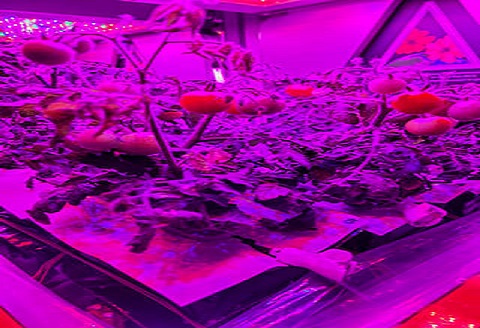
‘Red Robin’ dwarf tomato growing in Veggie hardware at the Kennedy Space Center. Image courtesy of NASA, ground study
The Dragon spacecraft carries scientific experiments and technology demonstrations that explore growing plants in space, creating nutrients on demand, in-space construction, and more. NASA Ames is working on nutrition research that aims to get humans closer to reaching Mars.
SpaceX’s 26th commercial resupply mission, scheduled for the International Space Station, will feature innovations such as space tomatoes, portable diagnostic kits, and yogurt bags that grow beneficial microorganisms.
Researchers have tested a plant growth unit called Veggie on the station, which has successfully grown leafy greens. The next step, Veg-05, focuses on growing dwarf tomatoes.
NASA Space Crop Production Scientist Dr. Gioia Massa is sending tomato seeds to the International Space Station to learn more about growing edible plants during space flight.
The tomatoes will be grown in plant pillows, space-grown bags filled with ceramic substrate, using a vegetable production system.

“We are testing tomatoes, looking at the impacts of light spectrum on how well the crop grows, how delicious and nutritious the tomatoes are, and the microbial activity on the fruit and plants,” said Gioia Massa, NASA Life Sciences project scientist and VEG-05 principal investigator. “We also are examining the overall effect of growing, tending, and eating crops on crew behavioral health. All of this will provide valuable data for future space exploration.”
Massa expects crew members to make three harvests during the 100-day experiment, and they’ll be asked to rate the tomatoes for taste. Astronauts will also take surveys “to assess their moods and any psychological benefits that growing plants may have when they’re living and working in this extreme environment,” Massa added.
Due to the lack of gravity, “water sort of sticks to surfaces and crawls,” Massa said, “So it can be really challenging.”
“It’s porous, so it helps trap water and air into the roots of the plants,” Massa said. “That’s one of the strangest things about growing plants in space, is really the behavior of water and trying to water your plants.”
The Moon Microscope Kit is a portable hand-held microscope and self-contained blood sample staining device, allowing astronauts to collect, stain, and take images of blood samples in case of illness.
Also read: SpaceX To Launch Of Japanese Moon Mission
Nasa is sending liquid resin packed inside a Nanoracks Black Box to explore in-space construction. This method reduces the time needed to produce key parts for daily mission use and may support future space construction of large structures like trusses and antennae.
The method also addresses the potential disruptions caused by weightlessness, the gravity of other planets, and Earth’s gravity during the return journey.
As astronauts pursue future space exploration, they need to be prepared for three different types of gravity fields, which can be dangerous due to space motion sickness.
Nasa is also sending the second of three packages of Roll Out Solar Array technology, which will expand the power-production capacities of the International Space Station (ISS).
To read more such news, download Bharat Express news apps


















